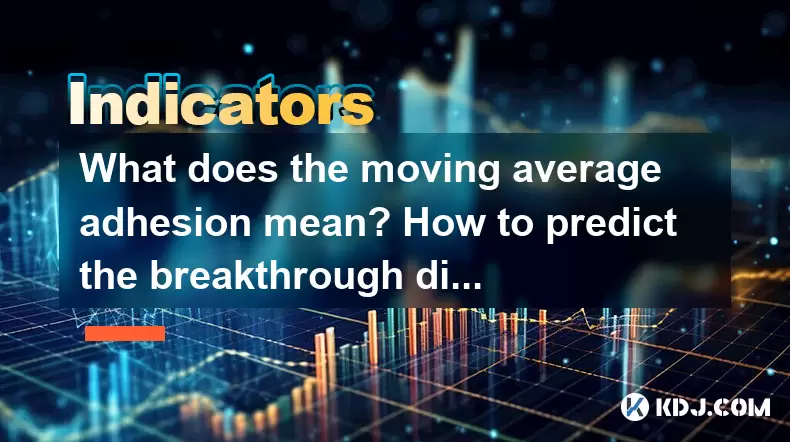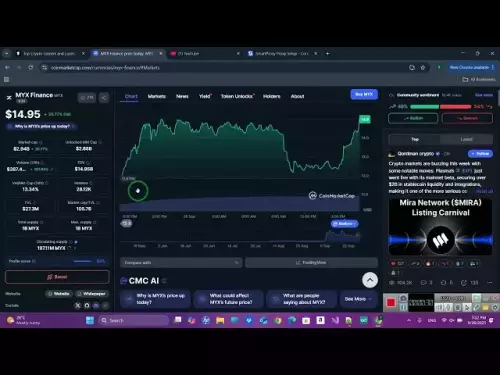-
 bitcoin
bitcoin $109547.008142 USD
0.04% -
 ethereum
ethereum $4011.838726 USD
-0.05% -
 tether
tether $1.000402 USD
-0.01% -
 xrp
xrp $2.798606 USD
0.88% -
 bnb
bnb $970.877944 USD
1.39% -
 solana
solana $202.237275 USD
-0.95% -
 usd-coin
usd-coin $0.999673 USD
0.00% -
 dogecoin
dogecoin $0.229294 USD
-1.15% -
 tron
tron $0.336370 USD
-0.45% -
 cardano
cardano $0.777260 USD
-1.66% -
 hyperliquid
hyperliquid $45.503019 USD
1.73% -
 ethena-usde
ethena-usde $1.000362 USD
0.01% -
 chainlink
chainlink $20.785303 USD
-1.10% -
 avalanche
avalanche $28.755822 USD
-0.11% -
 stellar
stellar $0.358303 USD
-0.48%
What does the moving average adhesion mean? How to predict the breakthrough direction?
Moving average adhesion helps traders predict crypto price trends by observing how prices stick to specific moving averages, aiding in setting trade entry and exit points.
May 22, 2025 at 12:14 am

What is Moving Average Adhesion?
Moving average adhesion refers to the phenomenon where a cryptocurrency's price tends to stick closely to a specific moving average line over a period. This behavior is crucial for traders as it can signal potential trends and provide a basis for making trading decisions. When a price adheres to a moving average, it often indicates that the market is respecting that average as a significant level of support or resistance.
In technical analysis, moving averages smooth out price data to create a single flowing line, making it easier to identify the direction of the trend. The most common types of moving averages are the Simple Moving Average (SMA) and the Exponential Moving Average (EMA). Adhesion to these lines can be observed in various time frames, from short-term (like 5-day or 10-day moving averages) to longer-term (such as 50-day or 200-day moving averages).
Why is Moving Average Adhesion Important?
Understanding moving average adhesion is essential for predicting future price movements. When a cryptocurrency's price sticks closely to a moving average, it suggests that the market is in a consolidation phase, where the forces of supply and demand are balanced. This balance can precede a significant move in either direction, making it a critical point for traders to monitor.
Moreover, adhesion to a moving average can act as a confirmation of the current trend. If a price consistently stays above a moving average, it indicates a bullish trend, while consistent adhesion below a moving average suggests a bearish trend. Traders often use this information to set entry and exit points for their trades.
How to Identify Moving Average Adhesion
To identify moving average adhesion, traders should follow these steps:
- Select the appropriate moving average: Depending on your trading strategy, choose a moving average that aligns with your time frame. Short-term traders might use a 5-day or 10-day SMA, while long-term investors might prefer a 50-day or 200-day SMA.
- Plot the moving average on your chart: Use a charting platform to add the selected moving average to your price chart.
- Observe price behavior: Watch how the price interacts with the moving average over time. If the price repeatedly touches or stays close to the moving average without breaking away significantly, you have identified adhesion.
- Confirm with volume: High trading volume during periods of adhesion can indicate strong interest and further validate the significance of the moving average.
Predicting the Breakthrough Direction
Predicting the direction of a breakthrough from a moving average adhesion requires a combination of technical analysis tools and market sentiment analysis. Here are some methods to help traders anticipate the direction of a breakout:
- Use additional technical indicators: Indicators like the Relative Strength Index (RSI), Moving Average Convergence Divergence (MACD), and Bollinger Bands can provide additional insights into potential breakout directions.
- Analyze candlestick patterns: Certain candlestick patterns, such as doji, hammer, or shooting star, can signal impending breakouts. A bullish candlestick pattern near a moving average can suggest an upward breakout, while bearish patterns may indicate a downward breakout.
- Monitor market sentiment: Social media, news, and other sources of market sentiment can influence the direction of a breakout. Positive news or sentiment can lead to an upward breakout, while negative sentiment can result in a downward breakout.
- Volume analysis: A significant increase in trading volume during a potential breakout can confirm the direction. Higher volume during an upward move suggests a bullish breakout, while higher volume during a downward move indicates a bearish breakout.
Practical Example of Predicting Breakthrough Direction
Let's consider a practical example to illustrate how to predict the breakthrough direction from moving average adhesion:
- Scenario: A cryptocurrency's price has been adhering to its 50-day SMA for the past month. The price has oscillated around this moving average, but never strayed far from it.
- Step 1: Add the 50-day SMA to your chart and observe the price behavior. You notice that the price has touched the SMA multiple times without significant deviation.
- Step 2: Use additional indicators. The RSI shows the cryptocurrency is not overbought or oversold, suggesting a potential breakout. The MACD indicates a bullish divergence, hinting at an upcoming upward move.
- Step 3: Analyze candlestick patterns. A bullish engulfing pattern forms near the 50-day SMA, suggesting a potential upward breakout.
- Step 4: Monitor market sentiment. Positive news about the cryptocurrency's upcoming developments is circulating, adding to the bullish sentiment.
- Step 5: Check volume. As the price starts to move above the 50-day SMA, trading volume increases significantly, confirming the bullish breakout.
Using Moving Average Adhesion in Trading Strategies
Incorporating moving average adhesion into trading strategies can enhance decision-making and improve the chances of successful trades. Here are some ways to use this concept:
- Trend following: If a cryptocurrency's price adheres to a moving average and consistently stays above it, consider entering long positions. Conversely, if the price adheres below a moving average, consider short positions.
- Breakout trading: Set up trades to capitalize on breakouts from moving average adhesion. Place buy orders above the moving average and sell orders below it, anticipating a breakout in either direction.
- Stop-loss and take-profit levels: Use the moving average as a reference point for setting stop-loss and take-profit levels. For example, if you enter a long position after an upward breakout, set your stop-loss just below the moving average to limit potential losses.
Frequently Asked Questions
Q1: Can moving average adhesion be used for all cryptocurrencies?A1: Yes, moving average adhesion can be applied to any cryptocurrency. However, the effectiveness may vary depending on the liquidity and trading volume of the cryptocurrency. More liquid assets tend to show clearer patterns of adhesion.
Q2: How long should I wait to confirm moving average adhesion?A2: The duration to confirm moving average adhesion can vary based on your trading time frame. For short-term traders, a few days to a week might be sufficient, while long-term investors might need to observe adhesion over several weeks or months.
Q3: Are there any risks associated with relying solely on moving average adhesion for trading decisions?A3: Yes, relying solely on moving average adhesion can be risky. It should be used in conjunction with other technical indicators and fundamental analysis to increase the accuracy of your trading decisions. Market conditions can change rapidly, and what appears to be adhesion might be a false signal.
Q4: How do I choose the right moving average for my trading strategy?A4: The choice of moving average depends on your trading style and time frame. Short-term traders might prefer shorter moving averages like the 5-day or 10-day SMA, while long-term investors might use longer moving averages such as the 50-day or 200-day SMA. Experiment with different moving averages to find which one aligns best with your strategy.
Disclaimer:info@kdj.com
The information provided is not trading advice. kdj.com does not assume any responsibility for any investments made based on the information provided in this article. Cryptocurrencies are highly volatile and it is highly recommended that you invest with caution after thorough research!
If you believe that the content used on this website infringes your copyright, please contact us immediately (info@kdj.com) and we will delete it promptly.
- SUI, AAVE, BlockDAG: Decoding the Hottest Trends in Crypto
- 2025-09-29 06:45:13
- Snorter Bot: Your Ticket to 100x Crypto Presale Gems?
- 2025-09-29 06:25:16
- Crypto Casino Craze: Bitcoin Gambling & No Deposit Bonuses in 2025
- 2025-09-29 07:05:17
- Stellar Holds the Line: Fibonacci Levels, Breakout Potential, and XLM's Next Stellar Move
- 2025-09-29 06:45:13
- XRP Payments, Daily Wages, and Ripple Chief: A Revolution in Payroll?
- 2025-09-29 06:25:16
- Bitcoin, MAGAX, and the Surge: What Savvy Investors Are Eyeing Now
- 2025-09-29 07:05:17
Related knowledge

What is a tower bottom candlestick pattern? Does it have a high success rate?
Sep 22,2025 at 07:18am
Tower Bottom Candlestick Pattern Explained1. The tower bottom candlestick pattern is a reversal formation that typically appears at the end of a downt...

What is a black hole pattern in the MACD indicator? Is it a cause for concern?
Sep 21,2025 at 06:54pm
Bitcoin's Role in Decentralized Finance1. Bitcoin remains the cornerstone of decentralized finance, serving as a benchmark for value and security acro...

How can I use the psychological line (PSY) to determine market sentiment?
Sep 17,2025 at 02:19pm
Understanding the Psychological Line (PSY) in Cryptocurrency TradingThe Psychological Line, commonly referred to as PSY, is a momentum oscillator used...

How can I determine if a double top pattern has officially formed?
Sep 21,2025 at 03:18am
Understanding the Structure of a Double Top Pattern1. A double top pattern consists of two distinct peaks that reach approximately the same price leve...

What is the Golden Valley pattern on the moving average? Is it better than the Silver Valley pattern?
Sep 21,2025 at 02:54pm
Understanding the Golden Valley Pattern in Moving Averages1. The Golden Valley pattern is a technical formation observed in cryptocurrency price chart...

What does a death cross of the RSI in the strong zone (above 50) mean?
Sep 17,2025 at 10:54pm
Understanding the Death Cross in RSI Context1. The term 'death cross' is traditionally associated with moving averages, where a short-term average cro...

What is a tower bottom candlestick pattern? Does it have a high success rate?
Sep 22,2025 at 07:18am
Tower Bottom Candlestick Pattern Explained1. The tower bottom candlestick pattern is a reversal formation that typically appears at the end of a downt...

What is a black hole pattern in the MACD indicator? Is it a cause for concern?
Sep 21,2025 at 06:54pm
Bitcoin's Role in Decentralized Finance1. Bitcoin remains the cornerstone of decentralized finance, serving as a benchmark for value and security acro...

How can I use the psychological line (PSY) to determine market sentiment?
Sep 17,2025 at 02:19pm
Understanding the Psychological Line (PSY) in Cryptocurrency TradingThe Psychological Line, commonly referred to as PSY, is a momentum oscillator used...

How can I determine if a double top pattern has officially formed?
Sep 21,2025 at 03:18am
Understanding the Structure of a Double Top Pattern1. A double top pattern consists of two distinct peaks that reach approximately the same price leve...

What is the Golden Valley pattern on the moving average? Is it better than the Silver Valley pattern?
Sep 21,2025 at 02:54pm
Understanding the Golden Valley Pattern in Moving Averages1. The Golden Valley pattern is a technical formation observed in cryptocurrency price chart...

What does a death cross of the RSI in the strong zone (above 50) mean?
Sep 17,2025 at 10:54pm
Understanding the Death Cross in RSI Context1. The term 'death cross' is traditionally associated with moving averages, where a short-term average cro...
See all articles










































































